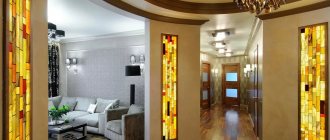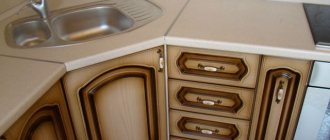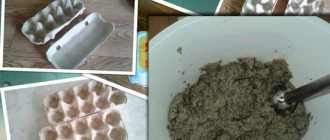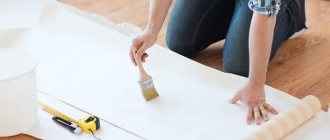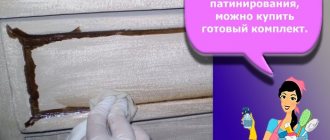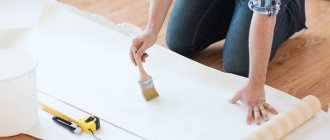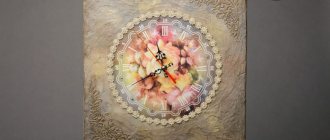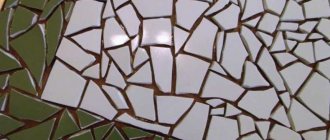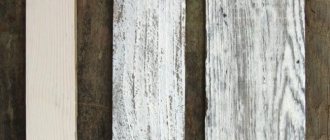Nowadays, not only ultra-modern designs are in trend, but also old or artificially aged furniture. Sometimes in some interiors objects that have scratches, peeling paint, faded color, or frayed edges .
Moreover, the sets or cabinets themselves may be completely new - they are simply made in this particular style. And a special technology helps to make them so – patination. What is patina on furniture? We'll figure it out by reading this material.
What is patina on furniture
You can create amazing beauty with your own hands
Popularity of aged furniture
Whatever one may say, everything new is well forgotten old. From time to time, things that look similar to those once used by our great-grandmothers come back into fashion. Moreover, despite the apparent antiquity, they look very stylish and organic. This also applies to furniture, and not just clothes or souvenirs, equipment or a number of other items. Moreover, it is not necessary to use exactly old things - in some cases they can be completely new, just artificially aged.
Patina and its types
Stain is often used to restore furniture
The effect of artificial aging can be achieved using a number of simple techniques. For this purpose, various chemicals, as well as mechanical or thermal methods can be used. Artificial aging is a technology of antique imitation . Moreover, it is possible to decorate not only furniture in this way, but also doors or windows, etc. Nowadays, aged furniture is considered quite prestigious and beautiful, it seems very reliable and often, contrary to the opinion that a person simply does not have the money to buy a new one, can be considered luxury item.
Classic white kitchen with gilding
Table. Methods for aging furniture.
| Methodology | Description |
| Chemical | This is the best way to age wooden furniture. Moreover, this is the easiest option that can be implemented at home. As a rule, it is simply enough to treat the furniture with some kind of chemical (for example, ammonia, if we are talking about hardwood) and that’s it. With coniferous facades you will have to tinker a little. However, the chemical method in any case involves the use of various chemical compounds, including paint. This technique also includes the so-called patination. |
| Mechanical | This option is suitable if you want to realize the effect that insects create during their life. That is, furniture treated in this way will appear to be eaten away by them. To do this, you will need to use an awl and nails, and use them to make small paths or depressions. The main thing is not to forget to clean the damaged surface from the resulting debris and cover it with a protective agent. |
| Thermal | This option is also quite simple and consists in burning out a number of elements using the same soldering iron or special devices. Its natural pattern will appear on the tree. It is enough to remove the accumulated carbon deposits with a brush and cover the surface with stain, and the furniture will turn into a real rarity. |
An impressive duet of craquelure and patina
Dear "Mr. Chest of Drawers"
On a note! The easiest way to artificially age objects made of wood is when it comes to doing it yourself.
Classic aging with acrylic paints
How to make furniture with a golden patina using wax
A win-win option for the final stage of decorating furniture is to imitate patina with gold wax. Metallic wax is available for sale in various shades of gold, bronze, tin, silver - in jars or tubes. It is applied in a very thin layer so that the imitation looks like a real patina.
To make a patina on furniture with your own hands using wax, follow these rules:
- Wax can be applied to the painted surface with your finger, gently rubbing, here and there creating the appearance of slight abrasion.
- Wax can also be applied with a swab made from a cosmetic disc or cotton cloth.
- Gold wax is especially suitable for patination of panels and corners on cabinet doors.
- Gold wax will help highlight the beauty of the carved part.
And in conclusion, we suggest that you familiarize yourself with a selection of photos of furniture with golden patina in various interiors of houses and apartments:
What is patina?
What is patination and what does the word “patina” mean? Previously, patina was the name given to an oxide film that forms on metal products and has a certain color. So, she tints copper with a malachite or bluish tint. Brass and bronze also boast the ability to develop a patina. More often, only antiquarians and collectors knew this word; it was rarely used in ordinary speech.
Patinated furniture in the interior
Patina is a little bit of a fairy tale in the house...
On a note! Interestingly, the presence of patina was not considered some kind of defect or something bad. On the contrary, its appearance is a sign of the quality of the product, which could last for many years and not collapse.
Aged items go very well with deliberately raw walls
Over time, the concept of “patina” has become more extensive - this is the name given to any plaque that appears during the aging process of a wooden or metal product. At the moment, the effect of artificial aging is also called patina, and the process of giving furniture an antique look is called patination.
Today patina is the effect of artificial aging
So we can distinguish three types of patina:
- natural or natural , which appears on its own after some time on metal products. The reason is the contact of the object with air, only the oxidation process occurs;
- artificial , which is also formed due to an oxidation reaction, but appears due to the effect of special substances on objects;
- decorative , which allows you to very quickly age an object and give it a special charm. It is this option that will be discussed in this material.
Metal old objects are a frequent design nuance in styles with patina
Country charm
Features of the technology
Patina was originally the name given to the thin oxide film that forms on the surface of copper.
The simplest and safest solution is to rub the wax composition into the relief grooves, corners and edges of the wood. After processing, a peculiar effect of natural contamination of the material is obtained.
In some cases, ordinary paints with the addition of aluminum or bronze powder, selected by color, are used. Such compositions can be purchased at almost any construction supply store .
It should be noted that do-it-yourself patination is a regular painting, where standard coloring compounds are replaced with special paints that do not have any effect on the structure of the wood. If desired, you can easily get rid of such coating.
In practice, artificial aging is often used to improve the appearance of interior items. From serviceable and durable wooden furniture you can create a retro-style interior. In addition, applying mixtures with a patina effect allows you to provide products with effective protection from external influences.
Patination
Nowadays, patination is actively used in the production and restoration of furniture, and both natural wood and the more common MDF panels can be aged. Furniture with a patina can look very rich without actually being expensive. Looking at such interior items, many people think that they see in front of them an ancient set that served some noble family for many years. But in fact, these cabinets were made at the factory just yesterday.
Furniture with patina can look very rich
On a note! It is easy to distinguish artificially aged furniture from furniture that has aged on its own. Just look at the inside of the headset. For artificially aged items, patination is performed only on the outside.
Creamy caramel color scheme with bright splashes
The option with patinated furniture is suitable for those who really love antiquity, but cannot afford to spend fabulous money on good and high-quality antique furniture. Most often, the patina option is used to decorate rooms in the Provence style.
The mirror takes center stage here, but check out the stunning triple table
By the way, some owners of new furniture can age the interior items themselves by patination themselves at home. This technology is not complicated, but it is labor-intensive, but if you want, you can do everything yourself.
Scandinavian style patina
Patination technology involves applying acrylic or other paint to the furniture façade and then grouting it. After that, it is enough to coat the furniture with a special composition (varnish) so that it acquires a matte shine and remains protected from external influences.
Looking at this authentic bureau, it is unclear whether it has aged naturally or artificially
On a note! The patination technique is often used to decorate chests of drawers, armrests of upholstered furniture, cabinet doors, kitchen units, and stools. In short, everything where there are wooden elements.
Boudoir bathroom in a country house
Detailed description of the compositions
Any thing can be given a noble surface, be it kitchen furniture or an antique cabinet.
The main thing is that the wooden product has texture. To treat metal and wooden surfaces, compositions on various bases are used. The difference between them lies in the degree of stability and adhesion to the base. Mordants . If you look around the situation in the house, you will probably find patinated wood products in it. If craftsmen use stain to paint wooden surfaces, then they most likely do not aim to give it special aesthetic properties.
Types of patina
An artificially created patina appears many times faster than a natural one. This is all explained by the rapid occurrence of chemical reactions that result from the action of certain chemicals on the surface of an object. In this way, you can imitate various shades - from golden to black, and sometimes you even manage to create a unique unnatural color combination.
Patination of furniture
Now there are 4 main types of patina. Let's take a closer look at them.
Table. Types of patina.
| View | Description |
| Liquid | This patina can be achieved using a special varnish called “patina”. It gives the product a yellowish tint. As a rule, it is used by artists who want to give their canvas a little aged look. When working with wood, this varnish is used at the completion stage. |
| Thick | The compositions that are used in this case have the consistency of a paste, usually two-component. Often sold as a set with a finishing patina and base. You can achieve the effects of gilding, rust, etc. A very common look. |
| Water based | This is something akin to paint, which is applied in various ways to the surface of the product. Suitable for many materials, including wood and metal, also used for aging ceramics. The work must be completed before the patina dries. As a rule, only 4 color options are produced - black, white, rust and green. |
| Faceted varnish | When dried, this substance can crack beautifully, creating a craquelure effect. The more layers of varnish applied to a product, the more cracks will form on it. The color range of the varnish is very rich. |
Artificially aged furniture in Provence style
What is patination wax for?
The waxy patina helps bring out the grain of the wood. It hardens for a long time, so it is easy to work with for beginners. The most common use for this type of patina is on small pieces of oak or ash. There is also an oil patina, which is similar in properties to wax, but is more versatile.
Patination is quite popular today, as it allows you to achieve a significant effect with minimal effort. Another advantage of the procedure is that it is easy to learn. Often even amateurs engage in patination.
If earlier the “old” style was given more to the interior of country houses, now it is becoming more and more in demand in apartments. Of course, to be able to implement this finishing method, you will need furniture made from natural wood.
What is needed for patination?
Having mastered the patination technique, you can, within a few hours, beautifully and harmoniously age furniture. Moreover, it will look really advantageous if the interior style suits it. Usually paints are used at home, but you will also need brushes, primer, varnish, sandpaper or a special sponge for sanding. As a rule, everything you need can be bought in office departments and partly in hardware stores.
Bed for a titled person
It is best to take two types of paints, for the bottom layer and for the top. The bottom layer can be anything, but the top layer is better made to look like metal (ideal options are gold or bronze).
Advice! Before starting to patina furniture, it is recommended to practice on some unnecessary piece of furniture. Even though the technology is simple, you still need to have some skills to make sure everything works out as it should. For example, you can try to patent a wooden box or an ordinary board.
First, it’s better to practice on some unnecessary objects
It is important to understand that you should not apply too much paint, otherwise you can ruin the texture of the wood and it will simply appear dirty. The coloring composition should be applied to flat surfaces that do not have any special protrusions. Also, you should not apply it where there is constant contact with surfaces (for example, on furniture handles) - the paint will not stick anyway.
DIY wooden chest
In our new article, we look at the best options for making chests with your own hands. Ideas, step-by-step instructions and tips can all be found in this article!
Tools and materials
Before work, you need to prepare all the necessary consumables - paint with an aging effect (with elements of bronze, silver, gilding), regular paintwork if you plan to repaint the product. Instead of paint, you can use wax, stain, shellac or mastic, depending on the chosen patination option.
Other process components that may be required:
- brushes of different sizes,
- roller (for large surfaces),
- sandpaper,
- primer,
- furniture or metal varnish,
- a rag to remove excess paint,
- cotton and foam swabs.
Some craftsmen additionally purchase metal powder if the effect of the paint seems insufficient: it is usually used to artificially age metal fittings. There are also ready-made kits for sale for patination and antique restoration - “Patina Verde Green”, “Patina Gold”, “Idea Patina”. Most of the products included in the kits are suitable for various materials - plaster, metal, wood.
How does patination occur?
Let's see how to patent an ordinary furniture box with your own hands, creating a scuffed effect on it.
Step 1. First of all, the box needs to be sanded using sandpaper. This procedure will get rid of unevenness and roughness. After the box has been sanded, dust should be wiped off with a cloth.
First, the box is sanded with sandpaper.
Step 2. Next, the places that should ultimately appear shabby should be treated with regular candle wax. These can be the sides of the box, as well as some places on its flat surface. The pre-treated surface can also be coated with wood primer. If primer is used, it should be applied in a thin layer.
The necessary areas are treated with candle wax
Step 3. Then the box needs to be coated with paint of the main color. In this case, white acrylic paint is used. It must be applied carefully with a brush to the entire surface of the box. This paint dries quickly, and you must wait for it to dry before carrying out further work.
Application of white acrylic paint
Step 4. Next, the box needs to be sanded again. The procedure will allow you to get rid of some of the paint, so you need to sand the surface in those places where the paint needs to be removed. It can be easily removed in areas that have been waxed. You need to work along the grain of the wood.
Re-sanding
Only those areas where paint needs to be removed are sanded.
Important! There is no need to use paper that is too rough. Otherwise, there is a risk of damaging the surface of the box.
Step 5. Next, the furniture needs to be given a dirty effect. It is created in the area of the corners of the drawer. And for this purpose a composition will be used, which is called patina. In this case, it is better to take a water-based one. A small amount should be applied to a palette or any plastic surface that you don’t mind getting dirty.
A small amount of patina is taken
Step 6. The best way to apply the patina is with a piece of sponge. It is necessary to lightly moisten the sponge with the patination compound and apply this composition to the surface of the furniture with gentle, gentle movements.
The sponge is moistened with a patination compound
Patina is carefully applied
Step 7. Next, after all the compounds have dried, you need to coat the surface of the box with varnish, preferably not glossy, but matte. The work is completed. All that remains is to dry the surface of the box, screw the fittings to it and you can use it.
Applying varnish
This is what the finished aged box will look like
By the way, patina can be applied in two layers. Then the colors will be more saturated. But you shouldn’t be overzealous, otherwise the furniture will look unnatural.
Video - Patination of furniture facade
Working with gold leaf: a simple master class with video
Using gold leaf, you can decorate a simple wooden chest of drawers. Below is a simple master class on working with gold leaf, where it is used in a “mosaic” version as an ornament on the flat surface of a chest of drawers. Also, the ornament can be applied through a stencil not in pieces, but as a continuous coating.
You will need:
- gold leaf in sheets (light gold);
- stencil with ornament;
- glue for gold leaf;
- synthetic brush for applying varnish;
- masking tape;
- ruler, chalk;
- oil varnish or finishing varnish for gold leaf
Whatever glue you use for gold leaf, always read the manufacturer's instructions and follow them strictly.
- Use masking tape to glue the ornament stencil onto the surface of the chest of drawers. Apply glue for gold leaf on it.
- Stencil small pieces of gold leaf onto the surface with glue, leaving gaps between them.
- Use masking tape to mark an even strip 2 cm wide, limiting it on both sides. Cover the strip between the pieces of tape with glue.
- Place pieces of gold leaf on the glue. After they stick, carefully remove the tape.
Watch the video of the master class on applying gold leaf to wood, which clearly demonstrates the stages of this process:
Thermal aging
First of all, take care of safety precautions. When burning wood, there should be no flammable objects or liquids nearby, and it is better to generally carry out such work in the fresh air. Be sure to check the serviceability of the burner or blowtorch.
Prices for various types of gas burners and blowtorches
Gas burners and blowtorches
Step 1. The workpiece is placed on a non-flammable surface or placed vertically, after which it is fired with a burner. The material is processed as evenly as possible, the top layer should be charred approximately 2-3 mm in thickness.
Processing wood with a torch
Technique for burning wood with a blowtorch
Thermal aging method
Step 2. After cooling, the charred carbon deposits are removed manually with a brush or using a grinder. The intensity and duration of this treatment depends on the desired texture.
Sanding burnt wood
Step 3 . Having formed the desired relief, take the grinding attachment and process the workpiece again. Here it is important not to overdo it and not remove excess, otherwise the aging effect will be insignificant.
Step 4. Since the color of the wood changed during firing, dark and light areas appeared, there is no need for painting. Now all that remains is to coat the material with colorless varnish or protective impregnation.
Thermally aged wood
Chemical aging method
The use of chemically aggressive substances requires special care and precision in work. Protective gloves must be used and the room must be well ventilated. The workpiece is pre-treated with coarse sandpaper and wiped from dust. Then apply alkaline agents or ammonia with a brush and leave for several hours. To slow down drying, you can cover everything on top with film. Under the influence of ammonia and alkalis, the surface acquires a gray tint, characteristic of old weathered wood.
Chemical aging method
When the color of the workpiece has completely changed, it is rinsed with water and then wiped with a vinegar solution (a tablespoon per glass of water) to remove the remaining alkali. If ammonia was used, a vinegar solution is not needed. After drying, the wood is brushed, sanded and a protective coating is applied. There is no need to paint such material, because then there is no point in chemical processing, and it is easier to do everything mechanically.
Artificial aging
